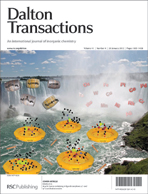A square-pyramidal organochromium(v) compound†
Abstract
The mononuclear, five-coordinate organochromium(V) compound [NBu4][CrO(C6F5)4] (1) has been obtained as a dark red solid in moderate yield by treatment of the homoleptic organochromium(III) derivative [NBu4]2[Cr(C6F5)5] with NO[BF4] in CH2Cl2 solution under an oxygen atmosphere. The CrV centre in the [CrO(C6F5)4]− anion shows a square-pyramidal geometry with the four C6F5 groups in the basal positions and the


 Please wait while we load your content...
Please wait while we load your content...